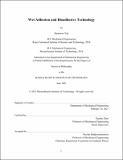Wet Adhesion and Bioadhesive Technology
Author(s)
Yuk, Hyunwoo
DownloadThesis PDF (65.32Mb)
Advisor
Zhao, Xuanhe
Terms of use
Metadata
Show full item recordAbstract
Along with the rise of complex and ever more capable technologies, our body is interacting with a rapidly growing number of man-made devices and machines ranging from biomedical devices for surgical repair and disease treatment to implantable electronics for monitoring and augmentation of bodily functions. Despite the recent advances, the interfacing between man-made devices and the human body – their interactions and communications – are still dominated by relatively primitive, short-term, low-efficacy, and incompatible strategies. Owing to their close similarity in mechanical, chemical, and biological properties, hydrogels – polymer networks infiltrated with a large amount of water – have emerged as an ideal candidate to interface these two dissimilar realms. However, conventional hydrogels have suffered various limitations to serve as an effective interface. In particular, one of the central challenges in the development and practical translation of hydrogel interfaces is robust, reliable, and functional integration to wet, dynamic, and living biological tissues. This dissertation aims to provide a comprehensive set of scientific and technological advances to address the challenges in wet adhesion and bioadhesive technology.
The first part of this dissertation is focused on the mechanics of wet adhesion. In particular, we will systematically discuss the mechanical design principles for achieving fast tough adhesion on wet surfaces covered by foulants. First, we propose the design principle for tough wet adhesion by a synergistic combination between the strong interfacial linkages and the mechanical dissipation in bulk tough hydrogels. Second, we propose the design principle for rapid wet adhesion by a dry-crosslinking mechanism that quickly removes the water on wet surfaces. Third, 3 we propose the design principle for foulant-resistant wet adhesion by a repel-crosslinking mechanism that cleans the foulants on wet surfaces. In the second part of this dissertation, we introduce a set of hydrogel interface technologies uniquely enabled by the wet adhesion in Part I. First, we introduce novel bioadhesive technologies in the form of a double-sided tape (DST) and a barnacle-inspired paste to achieve unprecedented rapid, robust, on-demand detachable, and blood-resistant adhesion on wet and injured tissues. Second, we introduce development and fabrication of high-performance conducting polymer hydrogels and their robust wet adhesion on a wide range of bioelectronic devices. Third, we explore a synergistic combination of bioadhesive and bioelectronic technologies for stable and functional interfacing between biological tissue and bioelectronic devices based on an electrical bioadhesive interface. In the last part of this dissertation, we will summarize and discuss the remaining challenges and opportunities in the wet adhesion and bioadhesive technology for seamless integration and communication between the human body and artificial devices and machines.
Date issued
2021-06Department
Massachusetts Institute of Technology. Department of Mechanical EngineeringPublisher
Massachusetts Institute of Technology